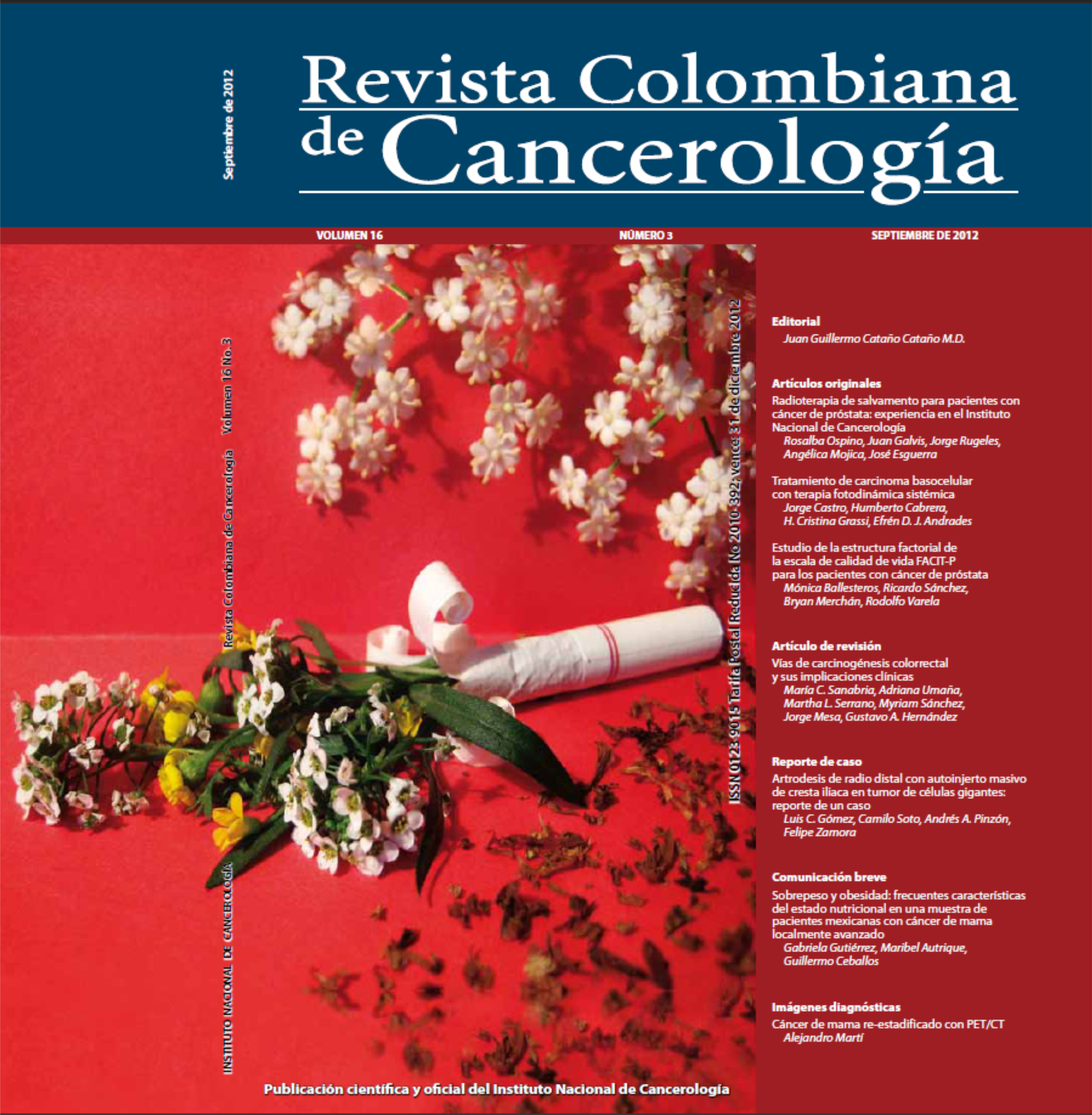Overweight and Obesity: Frequent Nutritional Characteristics in a Sample of Mexican Patients with Locally Advanced Breast Cancer
Keywords:
Breast neoplasms, nutritional status, overweight, obesityAbstract
Objective: To describe nutritional characteristics in patients diagnosed with locally advanced breast cancer treated at a public hospital in Mexico City.
Methods: A transversal study was performed to evaluate the nutritional state of breast cancer patients using diverse indicators: body mass index, theoretical weight percentage, waist-hip ratio and abdominal circumference.
Results: Forty-five patients were evaluated. In all the indicators studied in the sample, high levels of overweight and obesity prevailed. This fact, in turn, may be related to the rise in breast cancer incidence.
Conclusions: Breast cancer is the highest-ranked neoplasia in morbidity and mortality in Mexico. At the same time, the Mexican population has grown increasingly overweight and obese. This study ascertained that more than half of breast cancer patients are overweight or obese—an important risk factor linked to this neoplasia.
Author Biographies
Gabriela Gutiérrez, Instituto Politécnico Nacional
Sección de Estudios de Posgrado e Investigación, Escuela Superior de Medicina, Instituto Politécnico Nacional, México, D. F., México
Maribel Autrique, Universidad Iberoamericana
Universidad Iberoamericana, México, D. F., México
Guillermo Ceballos, Instituto Politécnico Nacional
Sección de Estudios de Posgrado e Investigación, Escuela Superior de Medicina, Instituto Politécnico Nacional, México, D. F., México
References
García M, Jemal A, Ward EM, et al. Global cancer facts & figures 2007. Atlanta: American Cancer Society Inc.; 2007.
Organización Mundial de la Salud (OMS). Cáncer [internet]. 2010 [citado: 1o de febrero de 2010]. Disponible en: http://www.who.int/mediacentre/factsheets/fs297/es/index.html.
American Cancer Society. Breast cancer facts & figures 2009. Atlanta: American Cancer Society, Inc.; 2009.
Instituto Nacional de Estadística, Geografía e Informática (INEGI). Estadísticas a propósito del Día Mundial Contra el Cáncer [internet]. 2009 [citado: 1o de febrero de 2010]. Disponible en: http://www.inegi.org.mx/inegi/contenidos/espanol/prensa/contenidos/estadisticas/2009/cancer09.asp.
Lara F, Arce C, Alvarado A, et al. Cáncer de mama. En: Herrera A, Granados M. Manual de oncología: procedimientos medico quirúrgicos. 2a ed. México: McGraw-Hill; 2003.
México. Secretaría de Salud México D. F. Programa de acción; cáncer de mama 2007-2012. México: SSA; 2007.
Voorzanger-Rousselot N, Garnero P. Biochemical markers in oncology: molecular basis and clinical uses. Cancer Treat Rev. 2007;33:230-83.
https://doi.org/10.1016/j.ctrv.2007.01.008
Gemignani ML. Breast cancer. En: Barakat RR, Bevers MW, Gershenson DM, et al. Handbook of gynecologiconcology. Londres: Martin Dunitz Ltd; 2000.
Organización Mundial de la Salud (OMS). Obesity and overweight [internet]. 2003 [citado: 26de febrero de 2010]. Disponible en: http://www.who.int/dietphysicalactivity/publications/facts/obesity/en/.
Pecorino L. Molecular biology of cancer. 2a ed. Londres: Oxford University Press; 2008.
Jasienska G, Thune I. Research pointers: lifestyle, hormones and risk of breast cancer. BMJ 2001;322:586-7.
https://doi.org/10.1136/bmj.322.7286.586
Olaiz-Fernández G, Rivera-Dommarco J, Shamah-Levy T, R, et al. Encuesta Nacional de Salud y Nutrición 2006. Cuernavaca, México: Instituto Nacional de Salud; 2006.
Lohman T, Roche A, Martorell R. Anthropometric standardization reference manual. Champlaign: Human Kinetics; 1988.
Habicht JP. Standardization of quantitative epidemiological methods in the field. PAHO Bull. 1974;76:375-84.
Metropolitan Life Insurance Company. Metropolitan height and weight tables. Stat Bull 1983;64:2-9.
Organización Mundial de la Salud (OMS). BMI classification [internet]. 2006 [citado: 31 de marzo de 2010]. Disponible en: http://apps.who.int/bmi/index.jsp?introPage=intro_3.html.
Organización Mundial de la Salud (OMS). Obesity: preventing and managing the global epidemic. Ginebra: OMS, Serie de Reportes Técnicos; 2000.
México. Secretaría de Salud. Norma Oficial Mexicana NOM-043-SSA2-2005. Promoción y educación para la salud en materia alimentaria: criterios para brindar orientación. México, D. F.: Diario Oficial de la Federación; 2006.
Sánchez-Castillo C, Berber A, Velázquez-Monroy O, et al. Anthropometric cutoff points for predicting chronic diseases in the Mexican national Health Survey 2000. Obes Res. 2003;11:442-51.
https://doi.org/10.1038/oby.2003.60
Resta F, Triggiani V, Sabbà C, et al. The impact of body mass index and type 2 diabetes on breast cancer. Curr Drug Target. 2004;4:327-33.
https://doi.org/10.2174/1568008043339686
Shappira DV, Kumar NB, Lyman GH, et al. Abdominal obesity and breast cancer. Ann Intern Med. 1990;112:182-6.
https://doi.org/10.7326/0003-4819-112-3-182
Stoll BA. Upper abdominal obesity, insulin resistance and breast cancer risk. Int J Obes. 2002;26:747-53.
https://doi.org/10.1038/sj.ijo.0801998
Connolly BS, Barnett C, Vogt KN, et al. A meta-analysis of published literature on waist-to-hip ratio and risk of breast cancer. Nutr Cancer. 2002;44:127-38.
https://doi.org/10.1207/S15327914NC4402_02
Sanz Pupo NJ, Fernández Sarabia PA, Bareto Fiu EE. Estado nutricional en pacientes adultas mayores con cáncer de mama. Rev Cubana Med. 2010;49(4).
Aguilar Cordero MJ, González Jiménez E, García López AP, et al. Obesidad y su implicación en el cáncer de mama. Nutr Hosp. 2011;26:899-903.
How to Cite
Downloads
Downloads
Published
Issue
Section
License
Todos los derechos reservados.




